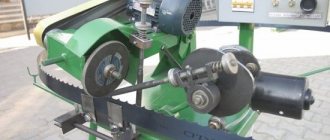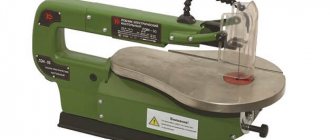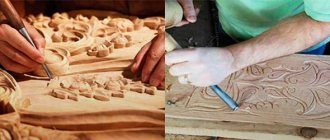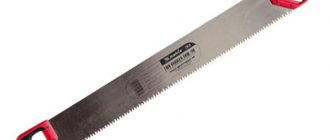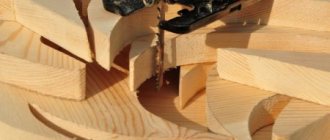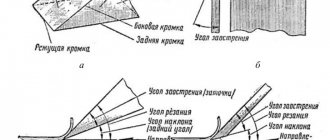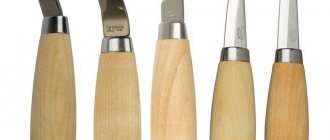In the process of rough processing of wooden and other surfaces, as well as for the formation of various recesses, a chisel is used.
This slotting tool looks like a chisel and is often used in carpentry, however, some types of it are used on drilling rigs preparing gas and oil wells.
The latter, strictly speaking, have almost nothing to do with classical bits, and got their name by “inertia” due to the fact that in the early period of development of drilling technology, well drilling was carried out using the percussion method.
Chisel purpose
Depending on which type it belongs to, the chisel is used to gouge out sockets, grooves and holes in various materials, and roughly process their surfaces, mainly using percussive actions.
The drilling type of tool is used for drilling wells for various purposes, including geological exploration, gas, water and oil.
There are also chisels that are used in medicine during surgical operations and autopsies.
What materials can a chisel work with?
Wood is processed with classic carpenter's chisels.
Options that are attachments for a hammer drill are used for working on stone, for example, granite, concrete, marble.
There is also a chisel for metal, but such a tool is more often called a chisel.
Drilling options work with soils of varying complexity, including their use for drilling out hard rocks.
Security measures
As previously noted, one must be very careful when applying significant force to a surface. The main safety recommendations include the following:
- When performing work related to chiselling, you need to ensure that the equipment used is in proper condition.
- Due to high-quality sharpening of the cutting edge, it is possible to obtain a more accurate and high-quality surface.
- To eliminate the possibility of making mistakes during work and getting injured, you should pay attention to the condition of the handle and striking part. Even minor damage to the grip ring can cause the handle to crack.
- Before starting work, care should be taken to ensure that the handle does not have significant defects. Chips and cracks can cause the tool to slip.
Do not forget that the chisel is a tool with a narrow focus. That is why it is undesirable to use it for other purposes.
Design, characteristics and principle of operation
Despite the fact that chisels, depending on the type, may have different designs, the similarity lies in the presence of a working part that acts directly on the material being processed, as well as a handle (for hand tools) or a shank for installation in the mounting chuck of the corresponding tool.
The handle may not have a solid structure, when the body of the base protrudes from its end, which provides reliable resistance to blows caused by a mallet or hammer.
The working part is made, as a rule, in the form of a sharp blade or peak, with the exception of drilling models, where the part in contact with the material being drilled is, in fact, a drill head.
Shank Types
Chisels for a rotary hammer or jackhammer are equipped with several types of shanks corresponding to the tool chuck:
- SDS-plus is the most widely used type of shank, which is used on light hammer drills.
- SDS-max – shanks for large bits and drills designed for heavy hammer drills.
- SDS-hex – for chisels and picks working in conjunction with jackhammers.
The tools can also be equipped with hex shanks for conventional three-jaw chucks.
Material
Chisels are made of steel; depending on the type of tool, different grades are used.
For example, for drilling options, steels 15H3MA (foreign analogue of AISI 4815H), 19HMA (analogue of AISI 8720), 14ХНЗМА (AISI 9115H), 55СМ5ФА (AISI S2) are used.
Tungsten-cobalt (pobedite) alloys are also used, sometimes nickel-tin or beryllium bronze, silver plating, and impregnation with silver-manganese alloys are used.
Manual versions are made of carbon tool steel, and their handle is made of hardwood.
Steel and bronze are used in the production of handle heads.
Dimensions and weight
The diameter of drilling options usually ranges from 76 to 660.4 mm, and the weight is 1.9 – 670 kg.
As for manual models, the length of their working part is 110 - 180 mm, the handle is 120 - 140 mm, the width and thickness of the blade are 6 - 25 mm and 4 - 8 mm, respectively.
Such products weigh between 180 and 630 g.
GOST
- GOST 1185-80 – for joinery and carpentry products.
- GOST 26474-85 – for diamond drilling heads and bits (types and sizes).
- GOST 20692-2003 – for roller-cone options (types and sizes)
Marking
According to GOST, a drill bit must be marked, which consistently indicates its type, diameter in millimeters, type of tool (by rock type), type of flushing/purging, type of support bearing, modification of the plant and serial number of the factory model.
Moreover, some characteristics have specific letter abbreviations and digital designations.
Marking of bit type:
- I – single-cone;
- II – double-cone;
- III – tricone.
Designation of the type of flushing or purging (location of channels):
- C – with central flushing;
- G – with hydromonitor side-type flushing;
- CG – with combined flushing;
- P – with central blowing;
- SG – with side blowing type.
Based on the type of support bearing, the following product categories are distinguished:
- B – on bearings with rolling elements, as well as with one/several thrust plain bearings, or without the latter.
- VU - on bearings with rolling elements, with several or one thrust sliding bearing, as well as with sealing of the support.
- H – radial sliding bearing, several, or one thrust sliding bearing, and the remaining bearings are sliding bearings.
- NU – the previous option, but with sealing of the support.
- A – at least two radial plain bearings, at least one thrust plain bearing.
- AU – the previous version, but with sealing of the support.
Depending on the type of rock for which the bit is designed, one of the following letter designations is located in the corresponding part of the marking:
- M – soft rock, tool with steel teeth.
- MZ is a soft abrasive rock with carbide teeth.
- MS – soft rock and interlayers of medium hardness, with steel teeth.
- MSZ – abrasive soft rock and medium-hard interlayers, with carbide teeth.
- C – steel teeth, for medium-hard rock.
- SZ – carbide teeth, for medium-hard abrasive rock.
- ST – steel teeth, for medium-hard rock with hard interlayers.
- T – steel teeth, for hard rock.
- TZ – carbide teeth, for abrasive hard rock.
- TK – carbide and steel teeth, for hard rock with strong interlayers.
- TKZ – carbide teeth, for abrasive hard rock with strong layers.
- K – carbide teeth, for hard rock.
- OK – carbide teeth, for very strong rocks.
NOTE:
The data listed above is taken from GOST 20692-2003.
Chisel: types and price
As you know, a chisel is the general name for a slotting tool, which includes hand-held models, special attachments for power tools, as well as options for drilling operations.
The latter differ radically in both design and method of application, and the shape of the working part.
Manual options, the cost of which averages 300 - 600 rubles, are divided into two types according to the method of application:
Plotnitskoe
For rough work including preparing grooves and cutting large quantities of material, such as when forming a roof truss system.
A characteristic feature of such a tool is a fairly wide blade, providing a large grip, and a total length exceeding 300 mm.
Visually, these models are comparable to a miniature spatula.
Carpentry
The same as a carpenter's chisel, but it is generally accepted that a carpenter's chisel is narrower. Designed for fine work, such as mortising door locks, in the production of wooden window frames and furniture.
The manual type also includes the corresponding anatomical instrument used in medicine to perform, for example, implantological and surgical operations.
Medical
Like carpentry or carpentry, it usually has a flat surface above the handle, which is struck with a hammer, but not always.
There are several main groups of such instruments:
- Otorhinolaryngological chisel – for chiseling and cutting bones when performing various ENT operations.
- Dental is the general name for slotting instruments used in dentistry. For example, a Zeffing chisel is a tool for special teeth cleaning, designed to remove tartar. During the work, poking movements are performed, without using any percussion instrument.
- Surgical is the general name for a slotting instrument used in surgery to remove bone tumors, trepanate bones, and cut off contaminated bone areas. For example, the Vojacek chisel was invented for trephination of the mastoid process, the Gokht chisel is used for cutting the bone. The latter is made in the form of a wedge-shaped plate, tapered on one side and rounded on the other side.
The peculiarity of manual models is that their design includes a handle by which the instrument is held in one hand, and with the other hand blows are made on its back side.
Here it is necessary to observe serious restrictions on the amplitude of the impact and impact force, which, accordingly, limits the use of the bit.
If you set the working part of the bit in motion in some “non-manual” way, you can increase the overall efficiency of the work.
Almost any hand tool has its more productive mechanical counterpart with a drive, in this case it is:
Electric chisel
A net tool used for fine wood carving is essentially a chisel by another name.
The electric chisel consists of a central control unit, a speed control pedal and a handpiece directly with an electric motor.
Some models are designed for use in dental laboratories.
The cost is around 3 – 5 thousand rubles.
Pneumatic chisel
Typically, professional pneumatic tools connected to compressor equipment look like a wrench.
A pneumatic chisel is used to gouge out sockets, grooves, and various holes; the working stroke is most often about 10 mm.
There are special subtypes of such tools created to perform specific tasks.
A striking example is a dental unpacking chisel, designed for quick unpacking of dental workpieces (for removing plaster and investment material).
Price 3 – 12 thousand rubles.
Hydraulic
Another type of mechanical tool driven by a working fluid distilled by a hydraulic pump.
Example - A high power, large size rod bit is used to perform a variety of applications to install ground connectors at varying depths.
In fact, this is a manual hammer for driving in grounding conductors.
Price 150 – 200 thousand rubles.
The working element of the types listed above are nozzles, which individually are also called chisels, usually come complete with the tool itself, and may have a specific shank, which makes them interchangeable.
The exception is the hydraulic chisel, since instead of a nozzle it directly acts on the driven ground rods.
There are also “different-sized” attachments with standard shanks, which are used as equipment for impact tools such as a jackhammer or hammer drill.
Their cost is usually 500 - 1000 rubles, depending on the size.
According to the shape of the working part, which acts directly on the material being processed, the chisel can be:
- Flat - a rod with a rectangular or trapezoidal cross-section, ground into a cone on one or both sides.
- Grooved - mainly used to form shaped sections, it has a transverse bend of a certain radius with a groove.
- Peak-shaped - most often used when performing construction and dismantling work, and therefore is often made as an attachment for an impact tool. The shape resembles a peak with a square, round, hexagonal or octagonal cross-section, hence the name.
- Channel - usually an attachment for a hammer drill, used for laying channels in concrete.
According to the body shape of the chisel, it is:
- Straight - the same width over virtually the entire length, regardless of the shape of the working part.
- Blade - with an extension of the working part, which can be at different distances from the shank or handle for different models.
Separate attention should be paid to drill bits, which are also called miner’s tools, as they are used, for example, for drilling wells in oil and gas fields by rotation.
Based on the nature of the impact on the soil, which leads to its destruction, as well as the design, the following types of tools are distinguished:
Roller bit
It can be crushing or crushing-chipping.
The working elements are rotating cutters, which are cutters with teeth of a special configuration. The most widespread is the tricone bit, as an ideal option for forming round wells.
- Diamond (sector) is an abrasion-cutting bit, often of a monolithic design, for drilling medium-hard and alternating hard rocks. Cutting elements are made from industrial diamonds of various qualities and sizes.
- Blade – cutting and shearing, allows you to drill soft viscous rock at high speeds. Depending on the number of blades, there are one- (peak-shaped), two-, three-bladed, and also six-bladed abrasive-cutting action.
- Milling - durable, resistant, often used for drilling wells and removing hard plugs.
- ISM type - increased wear resistance, with working inserts made of Slavutich - a super-hard material.
The tool described above is equipped with channels for washing or purging.
Depending on the location of these channels, flushing can be central, lateral, or combined, as mentioned above.
When drilling wells, special versions of the tool are often used, for example, cutting tools, which are used to ensure cutting in an open area.
Also popular is the auger bit, which is used for drilling water wells with drilling augers.
The cost of such a drilling tool can exceed 50 thousand rubles.
Agriculture also has its own chisels, but they are not an independent tool, but are used as working parts of corresponding machines and equipment.
For example, a subsoiler bit is driven deep into the soil, which actually loosens it.
Ploughshare chisel
Part of a plow share designed to strengthen it and cut the soil.
What is a chisel
A chisel is a hand-held cutting tool that is used for excavating small recesses, cleaning grooves, figured carvings and planing (removing a layer of small thickness). The tool consists of a metal blade (it must be well sharpened, otherwise the work will be done sloppily) and a handle (wooden or impact-resistant plastic). The junction is usually further strengthened.
Source: amazon.com
The difference between a chisel and a chisel can even be found in size. The standard size of chisels is 12.5-28 cm. The blade size is 11-14.5 cm in length and 0.4-5 cm in width. The chisel has a longer blade and overall length.
Chisels have different blade shapes: straight, curved or with a strong bend. The cross section can be flat, oblique, angular (two sides are connected at an angle of 60-90 degrees), semicircular.
By purpose, the tool is divided into:
- Carpentry . The chisel is used for fine and precise work, for example, for wood carving.
- Plotnitskaya . Used for roughing.
- Turning . It is used to work with parts that rotate on a lathe.
How to choose a chisel?
When choosing a bit for any task, you should focus on three main criteria:
- Purpose. For rough work, for example, when building a wooden frame, processing floor joists, you should choose a carpentry tool of a suitable width, and the wider, the greater the amount of material that can be removed in one pass. Delicate work requires narrow carpentry models with a cutting part of a suitable shape. In construction and dismantling work, attachments for a jackhammer or hammer drill are used.
- Material. The bit must withstand shock loads, and this especially applies to its cutting part. Although carbon steel is used in production, it varies in its characteristics. The cutting edge should not crumble, and this is the main parameter when choosing a tool.
- Cost and manufacturer. The previous point completely depends on it. You should not expect good performance from a cheap tool made by an unknown company. On the other hand, the cost of high-quality models is often unreasonably high due to the resonant brand. The optimal option, as always, is somewhere in the middle.
How to use
For household needs and working with wood, the user only needs traditional carpentry or joinery types. To make holes in concrete, stone or brick, use automatic equipment (perforators, jackhammers). There are rules to make using tools easier.
Features of work
When using household types, you must first secure the workpiece. Schematic markings are applied to the wood with chalk (pencil). A carpenter's chisel is suitable for creating notches along the contour. The cross-grain material is cut along the line. Then, using a carpenter's tool, they remove the shavings and carefully chop off the chips.
A wide chisel covers a large area of wood, which allows you to quickly process the surface. Hitting the handle with a hammer or mallet provides control over the strength and depth of the movements. A good sharpening of the blade edge will help prevent scoring and excessive chipping.
Application technology in pictures Source prof-sovet.ru
When working with a chisel, professionals do not recommend using material with knots. The recess line should not pass through former branches, otherwise uncontrolled removal of wood will occur. When chiseling with a hammer, it is easy to obtain the desired depth of holes or sockets.
The construction bit takes strong impacts from the hammer drill (chipper) and transmits waves through the metal to the contact area. The sharp leading edge of the working parts concentrates a lot of energy in a small area, so the tool quickly tears the surface material. The processed concrete, stone or rock cracks, and the nozzle penetrates into the inner layers.

